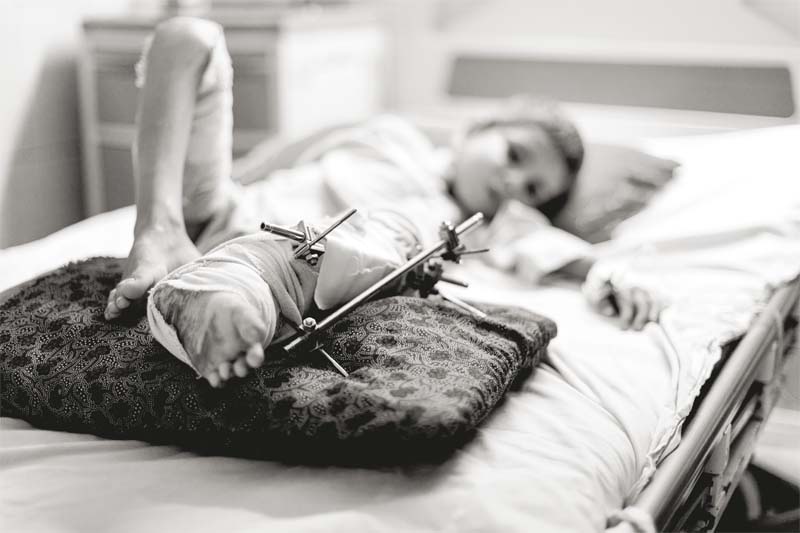
A scream from one of the wards breaks the peaceful quiet of the Burns Center at Civil Hospital, Karachi. The cry echoes in the sunlit corridors of the Victorian building and then dies down as nurses pacify the patient, tending to wounds and changing dressings. A doctor moves between the wards, complaining about a new patient with gangrene on his wounds, emitting a sickening smell, as she reads the medical reports of another. The doctor tells an attendant that his mother’s hand is so severely burnt, it has to be amputated and she says this with a calm which only comes after years of working at a burns unit. The attendant — a man from rural Sindh — calls her ‘doctor rani’ and communicates in his broken Sindhi-Urdu, trying to somehow save his mother’s hand which was burnt when she picked up a fallen high-tension electricity wire in her village. The doctor assures him that amputation will be the last resort.
The hospital is well maintained for a facility providing treatment free of charge. The 66-bed Burns Centre treats patients from all over Sindh and Balochistan and Ayesha Ali is one of them. As she shifts her bulky, bandaged body in a plastic chair, she stretches out her arm to show tiny purple blisters — one for every grain of daal that her pressure cooker sprayed over her body. Her left leg and abdomen are in worse condition and she says the pain is the same as it was nine days ago: unbearable. She is advised to walk as much as possible to avoid shrinking of her skin but she finds herself unable to because of the excruciating pain. Ali weeps as she recalls her ordeals at night and when using the restroom. She says she begs her doctors for painkillers but the request is dismissed on grounds of addiction. “Khuda kabhi kisi ghareeb ko beemar na karay (may God save poor people from illness),” she moans.

How to save a life: treating mental and physical wounds
The troubles that come with burn injuries often affect one’s judgment and ability to think objectively. While people fixate on physical wounds, the scars etched on the mind and soul are overlooked even though their healing is as crucial as the recovery of physical injuries. In a world where the survival rate of burn victims has remarkably improved in recent decades, one challenge remains — how to ensure the quality of the life that has been saved.
 First degree burns hurt the most but can be treated with simple first aid steps. PHOTO: ARIF SOOMRO
First degree burns hurt the most but can be treated with simple first aid steps. PHOTO: ARIF SOOMROMaimed and marred for everyone to see, burn survivors are exposed to the world; their scarred bodies tell their tale without any prompting. The survivor’s privacy is breached as he or she loses the right to remain anonymous in a crowd and exposure brings with it cruel reactions from naïve observers. “Burn survivors are social outcasts with low self-esteem; they are quiet and shy,” explains Dr Mohammad Fazlur Rahman, a plastic surgeon working with burns patients at Aga Khan University Hospital (AKUH). He adds that the dehumanising behaviour meted out to them leads to isolation, social withdrawal and feelings of stigmatisation.
Dr Ehmer al Ibran, the Burns Centre in-charge at Civil Hospital Karachi, says women and children are the worst when it comes to dealing with deformed burns survivors as their reactions can be brutal and unkind. “People, in their naivety, begin to dislike those who look different from everyone else,” he explains, sharing the story of an acid attack survivor whose own son refused to recognise her after the life-altering assault. “Try to imagine her trauma,” he adds.
says women and children are the worst when it comes to dealing with deformed burns survivors as their reactions can be brutal and unkind
 Psychiatric treatment is as important as the healing of physical wounds. PHOTO: ARIF SOOMRO
Psychiatric treatment is as important as the healing of physical wounds. PHOTO: ARIF SOOMROThe emotional toll that an altered body image has can be so intense that many survivors experience depression, anxiety and post traumatic stress disorder (PTSD) in some form or another. Dr Mansoor Khan, a medical officer at the burns ward at Khyber Teaching Hospital (KTH) Peshawar, says that a majority of survivors suffer from psychological problems. “The patients fall into depression within a week of the injury and are put on anti-depressants,” he says, adding that the burns victims stop eating and communicating with others and sleep less, overcome by their sadness.
“A female patient in our ward starts crying hysterically as soon as she sees a doctor,” he says, describing some of the effects of long-term hospitalisation required by burns cases. “She is a mother and yearns for her children who live in her village.”
Dr Mansoor’s colleague Dr Imran Khan, a psychiatrist, adds that many burns patients develop a phobia of whatever caused the injury, such as gas cylinders in the case of kitchen explosions. “The survivors fear being around what led to their injury,” he says, adding that many suffer from panic and anxiety attacks as a result. “The patients experience flashbacks of the event and develop a constant fear that the tragedy might occur again,” he explains. “They have the same dream over and over again and experience feelings similar to what they had experienced at the time of the incident.” Many burn injury survivors, he says, relive the trauma of the accident on a daily basis.
For many survivors, the pain is exacerbated by injuries that leave them physically unrecognisable. “If there is an aesthetic impairment, the normal functioning of a patient will be compromised as looks enhance or degrade human ego and a person’s self-esteem,” explains Dr Farhan Qureshi, a psychiatrist at Healthline, a Karachi-based private clinic. Qureshi says that such an altered self-image causes depression, which in turn leads to social phobias.
 Rehabilitation of burns survivors is a joint effort by doctors and family members. PHOTO: ARIF SOOMRO
Rehabilitation of burns survivors is a joint effort by doctors and family members. PHOTO: ARIF SOOMRODr Moazzam Nazeer Tarar, a plastic surgeon at the burns unit at Lahore’s Jinnah Hospital, says that many patients do not want to see their own faces after the accident. Tarar says the immediate reaction to a fire injury is the fear of death, which later turns into the fear of deformity. He stresses the significance of psychological counseling right from the beginning.
New body image, new identity
Dr al Ibran emphasises the importance of physiotherapy in the process of rehabilitation as psychological challenges emanate from a lack of physical wellbeing. As the body’s muscles begin to contract and shrink due to the injury, the patient is at risk of developing contractures — shortening and hardening of the muscles, tendons, or other tissue, that often leads to deformity and rigidity of joints — that can limit routine body functions
“Deformity disables the patient, leaving him or her unable to perform physical tasks and giving them an appearance which can result in psychological problems,” he says, adding that patients often become a burden on their families as they may be unable to return to work. Dr al Ibran places the blame for any deformity caused by lack of physiotherapy squarely on the patient. “No pain, no gain,” he says firmly. “You have to go through the excruciating pain that comes with physiotherapy in order to make sure bodily functions are not lost and you are not rendered useless,” he says with brutal honesty. “The patient will have to make that sacrifice as no one else will do it for them.”

Approaching doctors late after the injury is sustained means that some damage has already been done, and may be difficult to undo. While contractures are treated with grafting or rotation flap (wherein healthy skin is used to cover the injured skin), the process is very time consuming and expensive.
Dr Imran of KTH says survivors with deformities have serious concerns about returning to a normal routine. Additionally, AKUH’s Dr Rahman says patients should be told right off the bat that they may never return to looking the way they were used to. “To expect to be the same is unrealistic and patients must know that,” Dr Rahman says, urging honest doctor-patient discussions. “Pre-operation counseling is very necessary for this purpose.” However, such discussions are tricky, he admits, as patients are understandably very sensitive.
Dr Qureshi of Healthline says his primary focus in a burn injury case is to relieve stress and make the patient feel that he or she has a ‘safe space’ in which they can come to terms with their situation. “Medication must be incorporated in the treatment process along with psychotherapy, positive motivation and character reinforcement therapies,” he says. “This can take a few months, a year or even years depending on the severity of the condition.”
The rehabilitation of burn survivors goes beyond several months of hospitalisation and requires physicians, psychiatrists and plastic surgeons working with the family to help with the arduous process of creating a new self. “Burn patients may lack willpower and their integration back into society is not always easy,” cautions Dr Mansoor. “Many patients may have sustained their burns from a suicide attempt and talking to them is more difficult than counseling those burnt in an accident.” Dr Imran adds that those attempting suicide must also live with the guilt of causing trouble to their loved ones. “They live with remorse every day for what they put their families through, making them suffer emotionally and financially,” Dr Imran says, explaining that as medical assistance is expensive for many, some sell their valuables for the recovery process, while others travel from remote areas to reach a doctor.
The cost of recovery
While many government institutions provide physical and emotional assistance to burns patients free of charge or at affordable prices, private clinics in Karachi, Lahore and Islamabad charge between Rs1,000 and Rs5,000 for consultancy and between Rs1,500 and Rs10,000 per session, which lasts for 30 to 45 minutes. Discounts are offered on a case-by-case basis and prices vary depending on the number of sessions recommended to a patient. Healthline’s Dr Qureshi says psychiatric therapy would be relatively less expensive compared to the formidable amount needed for cosmetic and aesthetic rehab as doctors consider price cuts on humanitarian grounds.
He adds that the quality of assistance provided by private or government clinics and hospitals would be more or less the same. Discussing stress and depression, Dr Qureshi is of the opinion that psychological problems are not intrinsic but circumstantial which makes rehabilitation a little more complicated.
Slipping into depression greatly affects a person’s ability to move and eat, KTH’s Dr Mansoor says, adding that diet and mobility are two vital factors for recovery. While counseling for good diet and mobilisation is important, Dr Imran says patients also need to understand the importance of medicines as many choose to quit taking medication. “Patients blame changes in their bodies on the medicines they are taking and stop without their doctor’s approval,” he says.
The psychosocial care of burn patients needs to be a fundamental element of the overall recovery plan from day one. However, there appears to be a gap in the provision of this service in many burns units in Pakistan as only a few provide regular psychiatric help to patients along with care for physical wounds. The process of recreating oneself can be exhausting but with long-term support from doctors and family, burn survivors can bring some form of normalcy back into their lives.

Ferya Ilyas is a senior subeditor at The Express Tribune. She tweets @ferya_ilyas
Published in The Express Tribune, Sunday Magazine, August 16th, 2015.














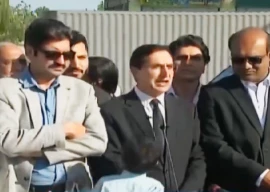
1713281138-0/US-Treasury-Secretary-Janet-Yellen-(2)1713281138-0-270x192.webp)

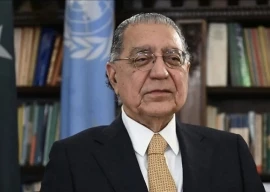
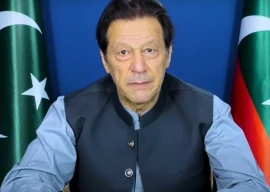
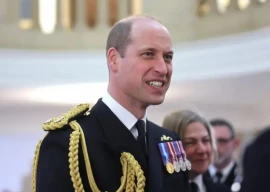





















COMMENTS
Comments are moderated and generally will be posted if they are on-topic and not abusive.
For more information, please see our Comments FAQ